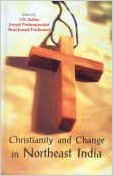This volume edited by T.B. Subba et.al. is a welcome addition to the growing body of literature on Northeast-related studies and enriches our knowledge of Christianity in India. For long, Northeast India, known as the region of ‘seven sisters’ comprising the states of Arunachal, Assam, Manipur, Meghalaya, Mizoram, Nagaland and Tripura and now also Sikkim, did not receive adequate scholarly attention. All too often, the premise that the Northeast is a ‘much misunderstood part of India’, led simply to the easy consignment of this region to a category that warranted no further exploration. However, in recent years, there have been many publications dealing with this much neglected region in India. The present volume engages itself with the continuing debate on various aspects of the Northeast, focusing chiefly on the role of Christianity.
As the introduction to the book states, the book emerged out of the idea of having ‘a healthy dialogue between the Indian social scientists and missionaries working on the Northeast India, to learn from each other’s knowledge and experiences, and to explore a common ground to serve the tribal societies of the region better.’ A proper understanding of the problems of the tribal Christians of this region would help to find the appropriate direction for those who are actively involved in the developments of the region. Such an approach much needed since in recent years, Christian ventures have been denounced by some as part of an evangelist agenda aimed at securing conversions.
The strong presence of Scheduled Tribes in these states in comparison with other regions of India, coupled with the rapid expansion of Christianity among them, is believed to have ‘conspired’ to distance them from the so-called Indian mainstream. Most of the tribals in Northeast are aboriginal hill people who had never been part of the Hindu mainstream. Within the multi-ethnic and multicultural setting of India, the region has a distinct regional identity both geographically and ethnically. The tribals of the Northeast have very few features in common with the rest of India – even with the tribals in other parts of the country. In the political parlance of India today, the very term “Northeast” has almost come to denote a region characterized by militant ethnopolitical movements, insurgency and separatism. On the other hand, the people of the region are seriously yearning to preserve their ethnic identity and foster peace, stability and development. The prevailing unrest in certain pockets cannot be dismissed as a mere law and order problem; it is essential to look for its roots in the problems of ethnic identity, cultural interaction, change of religion, and so on. If one wants to understand the background to the happenings in this region, here is the book.

